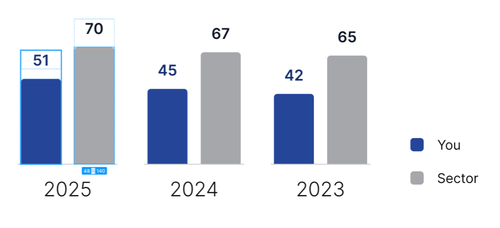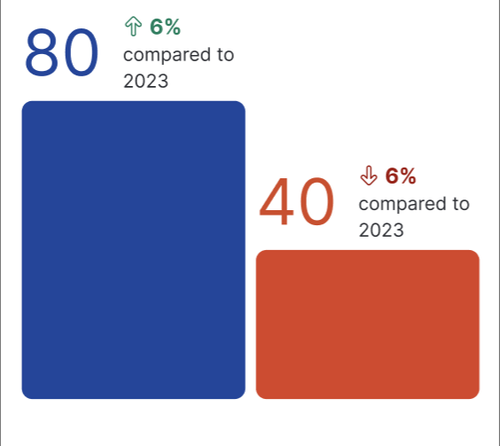Hi.
my chart bar design and legend items design does not match up

my kendo configuration
$("#my-score-chart").kendoChart({
transitions: false,
tooltip: { visible: false },
legend: {
orientation: 'horizontal',
position: "bottom"
},
plotArea: {
margin: { top: 20, bottom: 20, left: 20, right: 20 }
},
seriesDefaults: {
type: "bar",
spacing: 0,
gap:10,
highlight: { visible: false },
labels: {
visible: true,
position: "outsideEnd",
template: "#= value #"
}
},
series: [
{ name: "2025", data: [75, 75], color: "#254599" },
{ name: "2024", data: [50, 50], color: "#92A7E0" },
{ name: "2023", data: [25, 35], color: "#FFFFFF", border: { width: 1, color: "#616D80", dashType: "solid" } }
],
valueAxis: {
visible: false
},
categoryAxis: {
categories: ["Strategy & Leadership", "Governance"],
majorGridLines: { visible: false },
labels: { color: "#000" }
}
});Hello
I have a grid and each row can be expanded, using detailInit, to show an inner grid.
I fetch the data beforehand so that I can populate the grid using local data.
In inner grid I have a column with a delete button - using template I call a delete function passing this as a parameter.
// column definition
{
field: "delete",
title: "Delete",
width: 50,
template: "<span class='delete' onclick='delete(this)'><img src='.delete_icon.png'/></span>"
},my delete function :
function delete(e) {
let Loader = KENDO.KendoLoader($("body"));
try {
Loader.Show();
let row = $(e).closest("tr");
let grid = $(e).closest(".innerGrid");
let dataItem = KENDO.KendoGrid(grid).GetDataItem(row);
let innerRowId= dataItem.id;
let parentRow = row.parent().closest(".k-detail-row").prev();
let parentDataItem = KENDO.KendoGrid($("#ParentGrid")).GetDataItem(parentRow);
KENDO.KendoGrid(grid).DeleteUI([innerRowId]); // DeleteUI gets array of ids to delete , implemented below
// if no rows remain in inner grid, I need to update a column's value in the parent row
if (KENDO.KendoGrid(grid).HasRows() == false) {
grid.hide();
grid.siblings(".noRecordsFound").show();
let updatedDataObj = {
id: parentDataItem.id,
someColumnOnParentRow: null
}
KENDO.KendoGrid($("#ParentGrid")).UpdateUI([updatedDataObj]); // UpdateUI gets array of objects to update, implemented below
}
}
catch (error) {
debugger;
console.log(error.message);
}
finally {
Loader.Hide();
}
}We have created a own KENDO wrapper script for different widgets. Here is the kendoGrid code:
let KENDO = {
KendoComponent(jQueryElement, component, options = null) {
let kendoComponent = {};
kendoComponent.InitKendoComponent = function () {
let kComponent = jQueryElement.data(component);
if (!kComponent) {
if (options) {
kComponent = jQueryElement[component](options).data(component);
}
else {
kComponent = jQueryElement[component]().data(component);
}
}
return kComponent;
};
return kendoComponent;
},
KendoGrid(jQueryElement, options = null) {
let kendoGrid = {};
let kGrid = KENDO.KendoComponent(jQueryElement, "kendoGrid", options).InitKendoComponent();
if (options)
kGrid.setOptions(options);
kendoGrid.SetOptions = function (options) {
kGrid.setOptions(options);
return kendoGrid;
}
kendoGrid.GetData = function () {
return Array.from(kGrid.dataSource.data());
}
kendoGrid.GetDataItem = function (jQueryTableRow) {
return kGrid.dataItem(jQueryTableRow);
}
kendoGrid.UpdateUI = function (dataToUpdate = []) {
dataToUpdate.forEach(obj => {
let dataItem = kGrid.dataSource.get(obj.id);
if (dataItem) {
for (let prop in obj) {
if (prop !== "id") {
dataItem.set(prop, obj[prop]);
}
}
}
});
return kendoGrid;
}
kendoGrid.DeleteUI = function (idsToDelete = []) {
idsToDelete.forEach(id => {
let dataItem = kGrid.dataSource.get(id);
if (dataItem)
kGrid.dataSource.remove(dataItem);
});
return kendoGrid;
};
kendoGrid.HasRows = function () {
return kGrid.dataSource.data().length > 0;
}
return kendoGrid;
}
}It appears that UpdateUI does not function as it should.
When I test I notice that when the last remaining row of inner grid is deleted, the parent row's column is indeed updated to null, the No Records Found message is shown instead of the inner grid, the parent row gets collapsed, and when I expand it the inner grid is shown with the last remaining row.
Suprisingly, if I comment out the UpdateUI line, the inner grid's row gets deleted, without collapsing the inner grid and the No Records Found message is shown as intended (the parent row's column does not get updated in this case, obviously).
Is it a bug in Kendo ? or am I doing something wrong?


i realised the width of the width get change when the number of category changes.
example the bar width get bigger when category get lesser.
for column, the chart get center align.
what i wanted
for column type chart, to be left align when there is only 1 category
for bar type chart, to be top align when there is only 1 category
for all chart type, the width of the series item to be same irregardless of the number of category
For certain types of data in my grid, I need to define custom filter operators, e.g.:
updateOrAddFilter(fieldKey, {
field: fieldKey, operator: function (item) {
const nItem = normalize(item);
const nValue = normalize(value);
return nItem && nItem.includes(nValue);
}
});The updateOrAddFilter function then browses through the all the filters currently applied to the grid's dataSource, replaces old current-column filters with the new one and keeps all the other-column ones, and updates the grid's dataSource as such:
grid.dataSource.filter({ logic: "and", filters: updatedFilters });
Why is this happening? How can I fix it? Thanks in advance.
When I select initialize a kendoDropDownTree with checkboxes set to true, I experience all kinds of odd behavior visually. Inspecting the code shows that it is now a MultiSelectTree and not a DropDownTree yet there is no documentation and little support for this somewhat hidden component. I would actually prefer to have a MultiSelectTree without the checkboxes similar to a multiselect but with the grouping.
One issue, is that it does not respect the global settings for the corner radius of the box.
kendo.ui["DropDownTree"].fn.options["rounded"] = "none";
kendo.ui["MultiSelect"].fn.options["rounded"] = "none";
These seem to do nothing. When I guessed at "MultiSelectTree", I got a console error.
Another issue is that the UI looks very different from the regular multiselect and it doesn't seem to apply the .k-selected class as expected. When I check a box, the aria-checked is true but the k-selected class is not applied, this makes the item remain white rather than getting the blue background like it does in a regular multi-select. Can we get some consistency there?
Expanding an element does not change the height of the k-child-animation-container. It does show on the screen, but any styling targeting the container will not work because the container does not expand to fit the content.
I made my dropdown arrows 7px wider (k-treeview-toggle). Now the autoWidth makes the list 7px wider than the input element.


I am trying to support a drag event with the jQuery Splitter that is the same as the Angular Splitter version of sizeChange that is demonstrated here:
https://www.telerik.com/kendo-angular-ui/components/layout/splitter/events
I have tried attaching events to kendoDraggable, binding to layoutChange, etc., but nothing works to capture the real-time drag event as the splitbar is moved. Is there any known way to trap this event?
Thanks, Bob
can't seems to find an example for creating column chart looking similar to the image


My chart gets cut off
current issue

But it seems to be working properly on dojo
I have copied all my CSS and JS used on my site to dojo, but I still don't understand why it is not working on my site.
as the site is an internal site, I am not able to provide a link to the actual site.
I want to check how to add a custom label for column chart as shown in image below.

I've seen your demos on setting up the type: "date" and the format: stuff on the model and on the column display for the grid. Your demo sorts the dates as if they are dates properly. Ours shows the value as null if we set the type to date. It displays the string properly if we set it to type string but still sorts as a string. If we simply set the column to the kendo format and do not use a schema on the datasource, our code still sorts as a string.
https://dojo.telerik.com/TgCibbiL
When I looked at the data in your demo, it looks like the long form GMT. Today, we are instead blocking the script from sending the .NET property types of DateTime and instead sending a pre-formatted string of the date. Ran into some serialization issues when posting those same objects with DateTime properties on them.
Are you returning your DateTime properties as strings but formatted in this GMT when you serialize your .NET data objects back to the JavaScript handlers?









